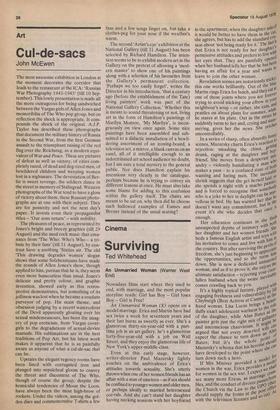Art
Cul-de-sacs
John McEwen
The most awesome exhibition in London at the moment decorates the corridor that leads to the restaurant at the ICA: 'Russian War Photography 1941-1945' (till 10 September). This lowly presentation is made all the more outrageous for being sandwiched between the Vargas girls of Allen Jones and memoribilia of The Who pop group, but on reflection the shock is appropriate. It compounds the shock of the original. A.J.P. Taylor has described these photographs that document the military history of Russia in the Second War, from the first German assault to the triumphant raising of the red flag over the Reichstag, as a modern equivalent of War and Peace. These are pictures of defeat as Well as victory, of cities completely razed, of dead and dog-tired men, of bewildered children and weeping women lost in a nightmare. The devestation of Berlin is sweet revenge, the soldiers dance in the street in memory of Stalingrad. Western photographs of the War tend to have a gloss of victory about them, these Russian photographs are at one with their subject. They are for posterity and not the next day's paper. It invests even their propagandist titles — 'Our sons return' — with nobility.
The pleasures of peace, as represented by Jones's bright and breezy graphics (till 29 August) and the mod rock music that emanates from 'The Who: Who's Who — a tribute by their fans' (till 31 August), by contrast have a soothing 'Sixties air. The old 'This drawing degrades women' slogan shows that some Solzhenitsians have made the rounds of Allen Jones's show, though applied to him, puritan that he is, they seem even more humourless than usual. Jones's delicate and pretty colour, and graphic invention, showed early as this retrospective demonstrates, but something of its jolliness was lost when he became a resolute purveyor of pop. His main theme, and obsession judging by a recent watercolour of the Devil apparently gloating over his sexual misdemeanours, has been the imagery of pop eroticism, from Vargas covergirls to the degradations of sexual-device manuals. His sublimations are in the best traditions of Pop Art, but his latest work makes it apparent that he is as painfully aware as anyone of what a cul-de-sac that can be.
Upstairs the elegant regency rooms have been lined with corrugated iron and plunged into sepulchral gloom to convey the threat and discontent of The Who, though of course the group, despite the homicidal tendencies of Moon the Loon, have always been the most high-brow of rockers. Under the videos, among the golden discs and commemorative T-shirts a few fans and a few songs linger on, but take a clothes-peg for your nose if the weather's warm.
The second 'Artist's eye' exhibition at the National Gallery (till 31 August) has been selected by Richard Hamilton. The intention seems to be to exhibit modern art in the Gallery on the pretext of allowing a 'modern master' to show one of his paintings along with a selection of his favourites from the Gallery's permanent collection. 'Perhaps we too easily forget', writes the Director in his introduction, 'that a century ago (before the establishment of the Tate) living painters' work was part of the National Gallery Collection.' Whether this is meant to sound threatening or not, living art in the form of Hamilton's paintings of Marilyn Monroe, 'My Marilyn', is incongruously on view once again. Some nice paintings have been assembled and submitted to a didactic installation of a bewildering assortment of an ironing-board, a television set, a mirror, a blank canvas on an easel, all of it intelligible enough to an indoctrinated art school audience no doubt, but I am sure a total mystery to the general public. Nor does Hamilton explain his intentions very clearly in the catalogue, perhaps because he is trying to convey six different lessons at once. He must also take some blame for adding to this confusion within the gallery itself. The chairs are meant to be sat on, why then did he choose such hallowed examples of Eames and Breuer instead of the usual seating?


































 Previous page
Previous page